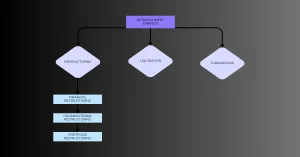You can unsubscribe at any time. For more details, review our Privacy Policy.
In This Article
Innovation: Reinforcing the Conversation
In times of economic uncertainty, navigating the delicate balance between expansion and retrenchment is both a challenge and an opportunity. In our recent article, we explored whether businesses should expand or retrench during downturns, concluding that a tailored balance often leads to resilience. You can read the article here. But how can companies put this concept into practice?
Today, we take the conversation further, diving into actionable strategies to help innovative service providers master the balancing act. How can your business confidently blend expansion and retrenchment to thrive in turbulent times? Let’s explore.
Revisiting the Core Debate: Expansion vs. Retrenchment
The debate between expansion and retrenchment during economic downturns is long-standing. Expansion proponents argue for seizing opportunities in emerging markets, while retrenchment advocates emphasize focusing on core competencies and preserving resources. But as we highlighted previously, success often lies in finding the right balance.
This balance requires companies to evaluate their unique circumstances, industry dynamics, and market trends. Let’s move beyond theory to explore how these strategies unfold in real-world scenarios.
Case Studies: Strategies in Action
Example 1: Expansion with Purpose
Netflix’s bold move into international markets during the 2008 recession demonstrates the potential of purposeful expansion. By investing in streaming services globally, the company not only diversified its revenue but also positioned itself as a leader in digital entertainment.
- Actionable Insight: Identify emerging markets or underserved customer segments where your core competencies meet unmet needs. Thoughtful investments can yield long-term gains even during a downturn.
Example 2: Strategic Retrenchment
Starbucks faced declining revenues during the same period but chose to close underperforming stores and streamline operations. This allowed them to focus on their core branding and deliver consistent quality, ultimately emerging stronger.
- Actionable Insight: Streamlining operations can free up resources for innovation while ensuring stability in core areas. Focus on efficiency without compromising your brand’s value.


Framework for Decision-Making
Balancing expansion and retrenchment requires a structured approach. Here is a four-step framework to guide your decisions:
Step 1: Assess the Landscape
Analyze current market conditions, customer needs, and competitor behavior. This insight will form the foundation of your strategy.
- Tools: Conduct SWOT analysis, leverage market research, and consult industry reports.
Step 2: Define Your Core Competencies
Determine which products or services deliver the most value to your business. Use these as a springboard for targeted innovation.
- Example: Leveraging customer feedback analysis or benchmarking against competitors using an advanced AI model, such as SentiSum, Thematic, Brandwatch or Semrush, can provide clear insights into your strengths and areas for potential growth.
Step 3: Innovate with Intention
Develop projects that align with both short-term needs and long-term goals. Pilot low-risk initiatives to test their viability before scaling.
- Example: Partner with complementary businesses to co-create offerings that address immediate customer demands.
Step 4: Monitor and Adapt
Track the performance of your strategies and remain agile. Use data-driven insights to pivot when necessary.
- Tip: Establish key performance indicators (KPIs) to measure success.
The Role of Leadership in Turbulent Times

Strong leadership is crucial to successfully navigating economic uncertainty. Leaders must prioritize:
- Communication: Keep teams and stakeholders informed about strategic decisions and their rationale. Transparency fosters trust.
- Vision: Inspire confidence by maintaining focus on long-term objectives while addressing immediate challenges.
- Flexibility: Embrace change and encourage a culture of adaptability within the organization.
The Conclusion: Turn Challenges into Opportunities

Economic uncertainty is as much an opportunity as it is a challenge. The businesses that thrive are those that master the balancing act of expansion and retrenchment. By focusing on core competencies, innovating with intention, and remaining adaptable, companies can build resilience and emerge stronger.
Far from being an either/or decision, navigating economic turbulence requires a nuanced, balanced approach. By implementing the strategies outlined here, your business can not only weather the storm but also position itself for sustainable growth.
Looking for deeper insights? Revisit our earlier discussion or stay tuned for our next article, where we explore how digital transformation plays a pivotal role in building resilience during economic uncertainty.






